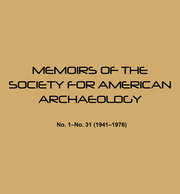No CrossRef data available.
Article contents
Chapter VI: Archaeological Collections from Tena Sites
Published online by Cambridge University Press: 27 June 2018
Extract
The specimens recovered from the sites visited on the Yukon and its tributaries, or acquired by purchase from others who had visited such sites, comprise about eighty types. In making this count I have considered the material of which the specimens were made, for example, listing netweights of stone as a different type from netweights of bone, and I have also treated the separate parts of composite implements, like harpoons, as distinct types. If I had considered each of the design elements used to decorate bone objects or pottery as separate types, the list would have had to be still further expanded.
Such a list is given below. In the first column are given the types represented by the supposedly Eskimo material from the vicinity of Holy Cross. In the second, are types from prehistoric Tena sites; in the third, types from Tena sites of uncertain age; and in the fourth, types from historic Tena sites, to which are added in parentheses the types actually seen in use in 1935.
- Type
- Research Article
- Information
- Copyright
- Copyright © Society for American Archaeology 1947
References
1 Osgood, 1940. The page references in this section are to this work.
1 de Laguna, 1934, p. 65.
2 Hrdlička, 1930a, Pl. 10, p. 135.
3 Handbook of American Indians, Vol. I, fig. on p. 313, first specimen on the left.
4 de Laguna, 1934, p. 168 ff.
5 Jenness, 1933, p. 392 and note 22; Collins, 1937a, pp. 154 f.
6 de Laguna, 1934, pp. 167 ff.
7 Jetté, 1908, pp. 315, 345.
8 N. C. Nelson, 1936, pp. 267 ff., Fig. 16; de Laguna. 1936a, pp. 8,10; 19356, pp. 32, 39.
9 de Laguna, 1934, p. 72.
10 de Laguna, 1934, Pl. 46,11.
11 Cf. also Jetté, 1908, p. 357.
12 This is proably the specimen he describes as a “chopping tool or scraper” (N. C. Nelson, 1937, p. 268).
13 Hrdlička, 1930 a, Pl. 11, esp. upper left.
14 Dall, 1870, fig. on p. 237.
15 de Laguna, 1934, pp. 90 f.
16 Geist and Rainey, 1936, p. 147, Pl. 48, 6.
17 Osgood, 1936, pp. 95,100; 1937, p. 124.
18 Specimen in PMH.
19 E. W. Nelson, 1899, p. 70.
20 E. W. Nelson, 1899, p. 58, Pl. XXVII, 19.
21 deLaguna, 1934, p. 117.
22 Dall, 1877, p. 82.
23 Dall, 1870, p. 95.
24 G. I Harrington, 1918, p. 65.
25 de Laguna, 1934, p. 178, Pl. 71.
26 de Laguna, 1934, Pl. 28.
27 Cf. “The Archaeology of Prince William Sound, Alaska,” in preparation with Kaj Birket-Smith.
28 de Laguna, 1934, p. 113; Osgood, 1936, Pl. 2; Birket- Smith and de Laguna, 1938, p. 395.
29 Dall, 1877, p. 95.
30 Whymper, 1869, pp. 204 f.
31 Dall, 1877, pp. 82 ff.


